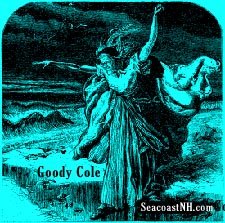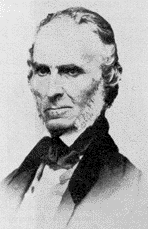|
FRESH STUFF DAILY |
|
|
||
|
|
||
|
|
||
|
SEE ALL SIGNED BOOKS by J. Dennis Robinson click here |
||
Page 1 of 3 Don’t mess with Goody Cole. In this seminal Seacoast ballad, John Greenleaf Whittier mixed two local legends into a spooky tale about witchcraft and death off the Isles of Shoals. Our coverage online includes the "backstory", a 1657 shipwreck report and the poets own notes on the story.
Read: Whittier in NH
Whittier also includes the character of Rev. Stephen Batchelder to whom he imagined he was related. This genealogical link, according to local historians, was apparently inaccurate. Related to a Hampton Minister or not, Whittier did write as many as a dozen poems focused in the region around Seacoast NH. Whittier's narrator "writes" the poem from Appledore Island, where Celia's circle of famous New England writers and artists gathered at her family's hotel. Looking back to the Hampton shore just eight miles away, he imagines the deadly storm, two centuries earlier. It appeared suddenly and swallowed a small boat. We know that Whittier, whose fame increased steadily in his later years, made many trips to the Isles of Shoals. A confirmed bachelor from nearby Amesbury, Whittier corresponded often with Mrs. Celia Laighton Thaxter. Modern fiction writer Julia Older has even speculated that their relationship was more than platonic, but that is extremely unlikely. Celia's grandaughter Rosamond Thaxter, in her book "Sandpiper" devoted an entire chapter to the relationship between the two poets from 1867-1892. When they collaborated at Appledore House, Celia was in her early 30s and Whittier just coming into his fame at age 60. Whittier may have known Celia when she was in her teens at her family hotel at Smuttynose too. Regarding "Wreck of Rivermouth" Whittier, using his formal Quaker style, wrote to Celia on August 8, 1868: "By the way, thee ought to like that poem, for it would scarcely have been written but for thee. The thought of thee and thy sea stories and pictures prompted it, and when writing I was wondering whether thee would like it." READ: The Original 1657 Story & Author's background Notes The poem first appeared in the Atlantic Monthly in April 1864, and later was included in the small book "The Tent on the Beach" which is also about the Hampton, New Hampshire area. Copyright © 2005 by J. Dennis Robinson. Article idea submitted by Janice L. Todd. Originally published on this web site in 1999.Illustration. Top Illustration An artist's wild concept of Hampton's Goody Cole from "The Poems of John Greenleaf Whittier" Revised Edition, 1879, Riverside Press.
Please visit these SeacoastNH.com ad partners.
News about Portsmouth from Fosters.com |
| Friday, April 19, 2024 |


|
Copyright ® 1996-2020 SeacoastNH.com. All rights reserved. Privacy Statement
Site maintained by ad-cetera graphics






 "
"














